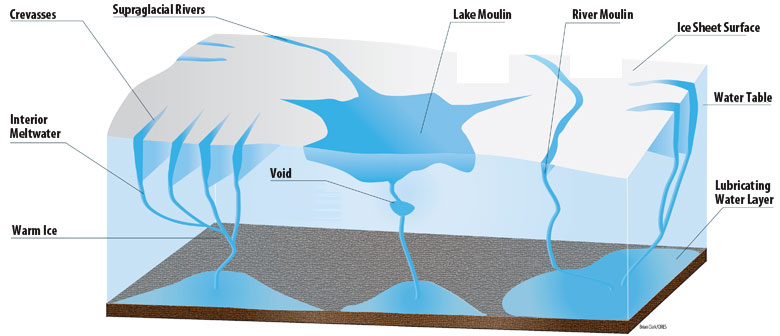
CIRES' sense of ice
Scientists have a pretty good idea that melt is responsible for about half the current loss of the Greenland Ice Sheet. Less well-understood are the mechanisms for the other 50 percent – the breaking apart of the ice itself and its loss into the sea. Now, several closely-related studies about water's effects inside glaciers and the Greenland Ice Sheet are revealing a clearer picture of the forces that influence the behavior and loss of ice.
Also of note was that water drains slowly in the months after the melt season, keeping the base water table high, around 80 percent of the ice sheet's total thickness, where it will be built upon the next year.
There's little concern, however, that the ice sheet could suddenly skate to the sea during peak melt season, due to the added water pressure below. "The calving of the ice as a result of this additional movement is not that significant in the grand scheme of things," said Colgan.
Warming the ice
Ice sheets are feeling the heat from within as meltwater flowing through them carries warmth to the interior via crevasses, fractures, and moulins. A new modeling study shows that such warming can greatly accelerate the thermal response of an ice sheet to climate change.
CIRES' postdoctoral researcher Thomas Phillips, Harihar Rajaram of CU-Boulder, and CIRES Director Konrad Steffen worked with models supported by physical data and found that an ice sheet can respond by warming on the order of decades, rather than the centuries projected by conventional thermal models.
"We are finding that once such water flow is initiated through a new section of ice sheet, it can warm rather significantly and quickly, sometimes in just 10 years," said lead author Phillips. "We've termed this process cryo-hydrologic warming."
Ice flows more readily as it warms, the newly named mechanism means that a warming climate can increase ice flows much faster than previously thought. It will still take thousands of years for the ice sheet to disappear, said Steffen.![]()
meltwater drainage via crevasses, which is often slow and steady, and thus less likely to influence the speed of the ice sheet.
Next up, McGrath says, is to watch the system evolve over an entire melt season. "This was just a snapshot in time."
Feeling the pressure
Porous ice sheets hold a lot of water, the effects of which are still relatively unknown. CIRES' graduate student William Colgan took a look inside moulins to see how the Greenland Ice Sheet handles the added pressure from meltwater. All signs point toward a temporary boost to the ice sheet's speed.
Colgan developed a model to study how meltwater moves from the surface of the ice sheet through its interior, and compared this model with ice velocity data collected from the field.
He found that the water table inside the ice rises and falls each year in response to summer melt. Furthermore, the ice sheet's velocity appears to be tied to how the water table rises each day. In high melt years, the water table rises quicker, creating a short-lived surge in movement. That's likely because the ice is buoyant, Colgan said. "We found that the ice isn't really bearing any weight. It's floating."
Matter of momentum
Fly over the Greenland Ice Sheet during the melt season, and there's a good chance you'll see turquoise rivers snaking their way across the ice surface. Often, mysterious drains, called moulins, swallow these rivers, taking water on a journey through the ice. While moulins have fascinated mountaineers and glaciologists for decades, little is known about where this water goes or its impact on the movement of the ice sheet.
On the Greenland Ice Sheet, CIRES' graduate student Daniel McGrath and colleagues installed a gauging station to measure meltwater drainage into a moulin, during a 15-day period at the peak of the melt season. Their plan was to study the timing of water traveling across the surface of the ice and the impacts of it falling into moulins.
McGrath and his colleagues found that although it takes about three hours for meltwater to travel through the ice surface stream system, once it enters the moulin, it is transferred to the water table below in less than 30 minutes, almost instantaneous by glaciological standards. Rapid pulses of meltwater can set off chain reactions that temporarily boost ice sheet velocity. These moulin surges differ from


